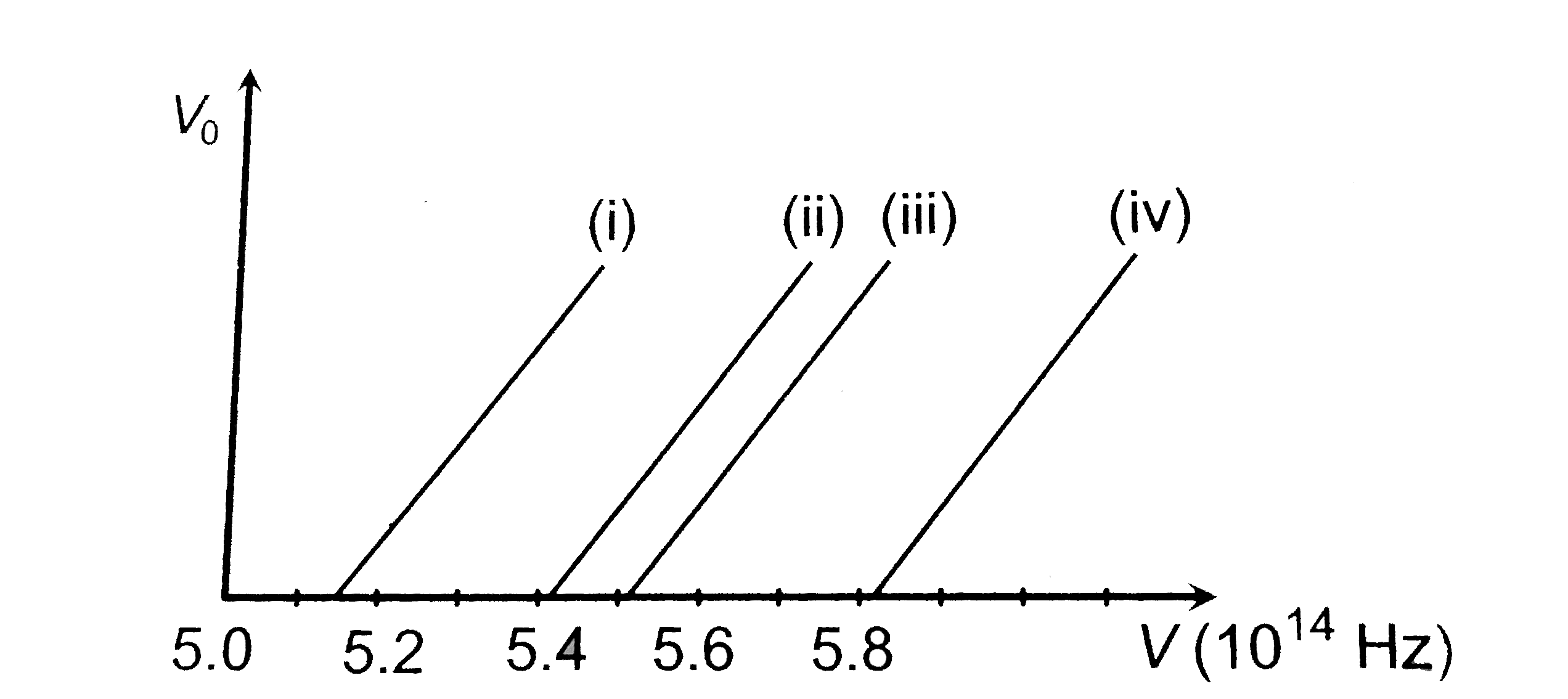Complete Solutions to dpp 3.3 of chapter ELECTRON,PHONTS,PHOTOELECTRIC EFFECT & X-RAYS of Class 12 book with complete answers and questions
| Class 12 | PHYSICS |
| Chapter | ELECTRON,PHONTS,PHOTOELECTRIC EFFECT & X-RAYS |
| CENGAGE PHYSICS DPP | dpp 3.3 |
| Number Of Questions | 15 |
| Academic Year | 2023-24 |
The figure shows different graphs between stopping potential `(V_(0))` and frequency `(v)` for photosensitive surface of cesium , potassium , sodium and lithium. The plots are parallel. Correct ranking of the targets according to their work function greatest forst will be

View SolutionIf maximum velocity with which an electron can be emitted is `4xx10^8` `cm s^-1` , then find the stopping potential `V_o` (mass of electron`=9xx10^(-31)` kg)
View SolutionLight of wavelength 2475 Å is incident on barium . Photo electrons emitted describe a circle of radius 100 cm by a magnetic field of flux density `1/sqrt17xx10^(-5)` tesla. Find the work function of the barium . (Given `e/m=1.7xx10^11`)
View SolutionIf light of wavelength `lambda_(1)` is allowed to fall on a metal , then kinetic energy of photoelectrons emitted is `E_(1)`. If wavelength of light changes to `lambda_(2)` then kinetic energy of electrons changes to `E_(2)`. Then work function of the metal is
View SolutionIn a photoemissive cell, with exiciting wavelength is changed to `(33lambda)/(4)`, the speed of the fastest emitted electron will be
View SolutionIn a photocell bichromatic light of wavelength `2475 Å` and `6000 Å` are incident on cathode whose work function is `4.8 eV`. If a uniform magnetic field of `3 xx 10^(-5) Tesla` exists parallel to the plate , the radius of the path describe by the photoelectron will be (mass of electron ` = 9 xx 10^(-31) kg`)
View SolutionTwo metallic plates A and B, each of area `5xx10^(-4)m^(2)`, are placed parallel to each other at a separation of 1 cm. Plate B carries a positive charge of `33.7xx10^(-12)C`. A monochromatic beam of light, with photons of energy 5 eV each, starts falling on plate A at t=0 so that `10^(16)` photons fall on it per square metre per second. Assume that one photoelectron is emitted for every `10^(6)` incident photons. Also assume that all the emitted photoelectrons are collected by plate B and the work function of plants A remains constant at the value 2 eV. Determine the number of photoelectrons emitted upto t = 10 s.
View SolutionIn the arrangement shown in figure, `y = 1.0 mm`, `d = 0.24 mm and D = 1.2 m`. The work function of the material of the emitter is `2.2 eV`. Find the stopping potential `V` needed to stop the photocurrent.

View SolutionPhotoelectric emission is observed from a metallic surface for frequencies `v_(1)` and `v_(2)` of the incident light rays `(v_(1) gt v_(2))`. If the maximum values of kinetic energy of the photoelectrons emitted in the two cases are in the ratio of `1 : k` , then the threshold frequency of the metallic surface is
View SolutionLight from a hydrogen discharge tube is incidenton the cathode of a photoelectric cell. The work function of the cathode surface is 4.2 eV. In other to reduce the photocurrent to zero, the boltage of the anode relative to the cathode must be made
View SolutionWork function of lithium and copper are respectively `2.3 eV` and `4.0 eV`. Which one of the metal will be useful for the photoelectric cell working with visible light ?
`(h = 6.6 xx 10^(-34) J - s, c = 3 xx 10^(8) m//s)`
View SolutionThe work function of a certain metal is `(hC)/lambda_(0)`. When a monochromatic light of wavelength `lambda lt lambda_(0)` is incident such that the plate gains a total power `P`. If the efficiency of photoelectric emission is `eta%` and all the emitted photoelectrons are captured by a hollow conducting sphere of radius `R` already charged to potential `V`, then neglecting any interaction of potential of the sphere at time `t` is:
View SolutionA physicist wishes to eject electrons by shining light on a metal surface. The light source emits light of wavelength of 450 nm. The table lists the only available metals and their work functions.
`{:("Metal",W_(0)(eV)),("Barium",2.5),("Lithium",2.3),("Tantalum",4.2),("Tungsten",4.5):}`
Which metal(s) can be used to produce electrons by the photoelectric effect from given source of light?
View SolutionA physicist wishes to eject electrons by shining light on a metal surfac. The light source emits light of wavelenght of 450 nm. The table lists the only available metals and their work functions.
`{:("Metal",W_(0)(eV)),("Barium",2.5),("Lithium",2.3),("Tantalum",4.2),("Tungsten",4.5):}`
Which option correctly identifies the metal that will produce the most energetic electrons and their energies?
View SolutionA phsicist wishes to eject electrons by shining light on a metal surface. The light of wavelength of 450nm. The table lists the only available metals and their work functions.

Which metal(s) can be used to produce eletrons by the photoelectric efffect from given source of light ?
View Solution
dpp 3.3 questions and complete solutions for chapter ELECTRON,PHONTS,PHOTOELECTRIC EFFECT & X-RAYS of CENGAGE PHYSICS (ENGLISH) of Class 12